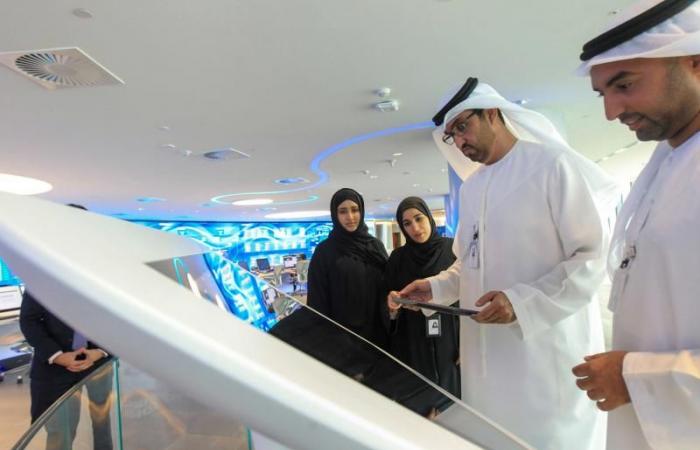We show you our most important and recent visitors news details New gas discoveries promise to change regional landscape in the following article
Hind Al Soulia - Riyadh - Natural gas is expected to account for the biggest share in the global energy mix in the years ahead.
Sultan Ahmed Al Jaber, UAE Minister of State and the Abu Dhabi National Oil Company (ADNOC) Group CEO talks to employees at the Panorama Digital Command Centre at the ADNOC headquarters in Abu Dhabi, UAE December 10, 2019. (Reuters)
Dubai - New discoveries of gas reserves around the Middle East are changing the regional landscape and outlook for gas pricing, supplies and the geopolitical balances those supplier-buyer linkages create.
A growing number of regional players are emerging alongside traditional heavyweight Qatar, which has been the world’s most important supplier of liquefied natural gas (LNG) to the international market, and Iran, which has the world’s second-largest proven natural gas reserves. US sanctions, however, mean Tehran cannot unlock their full economic potential.
Abu Dhabi National Oil Company (ADNOC) recently announced the discovery of huge gas reserves, estimated to be 80 trillion cubic feet, between Dubai and Abu Dhabi. The discovery comes after Abu Dhabi announced major finds last November as well, including an estimated 58 trillion cubic feet of conventional gas — taking its total proven reserves to 273 trillion cubic feet — and 160 trillion cubic feet of unconventional gas, together with the discovery of another 7 billion barrels of crude oil.
Sharjah National Oil Corporation (Snoc) and Italian energy company Eni announced the discovery of the Mahani reserve, Sharjah’s first new onshore natural gas discovery in more than three decades.
The United Arab Emirates is estimated to consume around 10 billion cubic feet of gas per day, around one-third of which is imported to meet demand, particularly for power generation. Dubai, for which the shallow reservoir near Jebel Ali will be prioritised for development, consumes around 1.5 billion cubic feet of gas a day, much of it from Qatar, which remains under embargo from the Saudi-led coalition.
Recent discoveries place the United Arab Emirates’ gas reserves as the world’s sixth-largest and bolster its prospects for achieving self-sufficiency within a few years.
With gas fields in Hail and Ghasha off the coast of Abu Dhabi set to start production over the same time frame, discoveries such as Jebel Ali, said to be the fourth-largest in the region and the biggest find anywhere since 2005, position the country strongly to develop onshore liquefaction facilities and become a net exporter. They should also help to cultivate gas-dependent industries at home, such as petrochemicals, for which ADNOC is aiming to triple output by 2025.
Recent finds could also help the United Arab Emirates, a key OPEC member and the world’s fourth-largest crude supplier, mitigate the potential effects of depressed oil prices and production cuts being weighed by OPEC to address flailing oil demand.
Natural gas is expected to account for the biggest share in the global energy mix in the years ahead because it is a more efficient and cost-effective alternative to more polluting and carbon-intensive fuels, such as coal and oil. Power generation and industrial sectors will be the primary drivers of growth in natural gas demand around the world over the coming decades.
Israel has begun exporting natural gas to Egypt via a subsea pipeline from its Leviathan offshore gas field in the Eastern Mediterranean. The Egypt-Israel gas partnership involves the purchase of more than 3 trillion cubic feet of gas worth an estimated $19.5 billion over the next 15 years by Egypt. The supply rate from Leviathan will rise from 74 billion cubic feet per year to 166 billion cubic feet per year by 2022. Israel aims to export gas to Egypt from its Tamar offshore gas field this year as well.
Last year, Egypt convened the East Mediterranean Gas Forum with the participation of Jordan, Cyprus, Greece, Italy, Israel and the Palestinian territories to build regional cooperation and develop a common approach to the region’s gas resources.
Egypt operates gas liquefaction stations in Idku and Damietta, which form the foundation of its strategy to become a gateway for the region’s natural gas supplies to international markets. Egypt is exporting 1 billion cubic feet of gas to Europe every month via ten shipments, a number it wants to double once it restarts the Damietta plant.
Europe’s demand for natural gas stands at approximately 200 billion cubic feet per day and is growing but many of its leaders want to reduce dependence on Russia, which supplies around one-third of European imports. Weeks ago, an agreement was signed between Israel, Cyprus and Greece for the EastMed gas pipeline project that may carry as much as 30 billion cubic feet of natural gas every day from offshore gas fields in the Eastern Mediterranean to Europe via Greece.
Israel has initiated discussions with Egypt and India to export surplus gas to India, one of the world’s largest importers of LNG along with China. India is said to have 18,000 megawatts of gas-based power projects lying idle as it battles to renegotiate a standing contract with Qatar — prices for LNG have plummeted since it was last renegotiated in 2015.
China is expected to account for close to half of growth in global LNG demand in the next five years and will soon overtake Japan as the largest natural gas importer. LNG prices have suffered considerably against the price of crude oil in recent years; however almost all of the world’s major economies have ambitious targets to bolster the share of natural gas into their energy mix.
It is ironic that the price of LNG has been falling owing to, among other factors, the explosion in shale production in the United States as well as uncertain demand in a global economy being hampered by trade wars and now a potential global epidemic in the shape of coronavirus.
Turkish naval and drilling activity in the Eastern Mediterranean as well as a controversial maritime delimitation agreement with Libya reinvigorated regional rivalries, however, and serve as a reminder that the discovery of natural resources in the Middle East will also intensify geopolitical fault lines.
Sabahat Khan is a senior analyst at the Institute for Near East and Gulf Military Analysis (INEGMA).
These were the details of the news New gas discoveries promise to change regional landscape for this day. We hope that we have succeeded by giving you the full details and information. To follow all our news, you can subscribe to the alerts system or to one of our different systems to provide you with all that is new.
It is also worth noting that the original news has been published and is available at The Arab Weekly and the editorial team at AlKhaleej Today has confirmed it and it has been modified, and it may have been completely transferred or quoted from it and you can read and follow this news from its main source.


